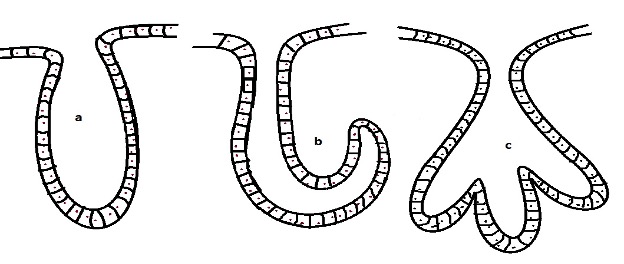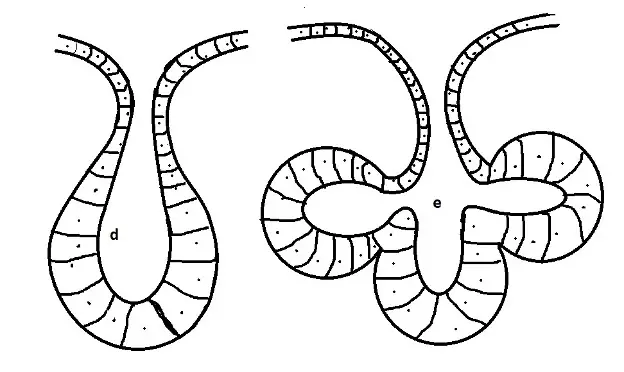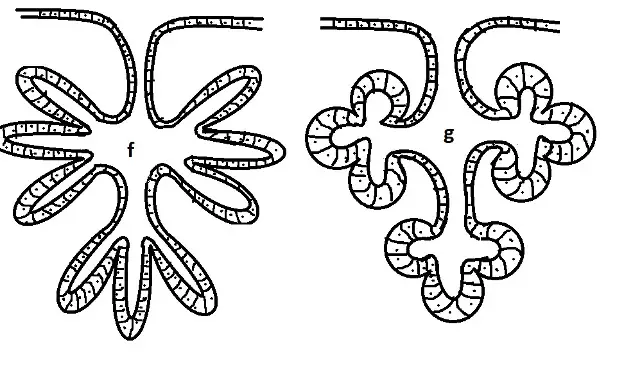Endocrine and Exocrine Glands
** Definition, Histology & Similarities
Definitions
Essentially, a gland consists of a group of cells, secretory epithelial cells, that work together to synthesize and release various products (e.g. hormones).
Depending on where they release their products, glands are divided into two main groups that include:
Endocrine glands - Endocrine glands belong to the endocrine system and are commonly referred to as ductless glands. Because ducts are absent in this system, products are released into the bloodstream via the extracellular space so that they can be transported to the target site. Some examples of endocrine glands include the pineal and adrenal glands.
Exocrine glands - Exocrine glands include glands associated with their own ducts. In this system, products are released directly into the ducts so that they can be transported to the target sites. Some examples of exocrine glands include sweat glands and salivary glands.
* Exocrine glands can also secrete their products directly on the surface (e.g. some cells lining the epithelia).
Histology
There are different types of exocrine glands which are classified based on a number of important characteristics that include:
· Cellular organization: Unicellular vs multicellular exocrine glands
· Structure of the duct: Simple vs compound duct system
· Shape of the secretory units: Tubular, acinar, and tubuloalveolar
· Type of products secreted: Serous, mucus, seromucus
· Mechanism of product secretion: Merocrine, apocrine, and holocrine
Cellular Organization
Based on organization, exocrine glands are divided into two main categories that include unicellular and multicellular exocrine glands. As the name suggests, unicellular exocrine glands are characterized by a single secretory cell type. One of the best examples of unicellular exocrine glands are goblet cells.
These cells are scattered in the intestinal epithelium where they are referred to as intraepithelial secretory cells/glands. They are characterized by a goblet shape (wine glass shape) consisting of a broad opening at the apical region and a narrow base and are involved in mucin secretion.
Generally, these glands occur singly (scattered from each other) and are surrounded by the cells of the epithelial surface (non-secretory epithelial cells).
These types of glands also lack ducts and therefore release their products (e.g. mucus) directly on the epithelial surface. For instance, in the epithelial lining and the trachea, goblet cells release their secretions (mucin) on the surface which serves a variety of functions (e.g. it acts as a lubricant in the digestive tract).
Unlike unicellular glands, multicellular exocrine glands consist of clusters of cells that usually secrete their products into surfaces through ducts. Some examples of multicellular exocrine glands include the pancreas and sweat glands.
Typically, these glands are formed through the proliferation and invagination of specialized epithelial cells into the underlying connective tissue. During development, the terminal region becomes the secretory unit while the other portion gives rise to the duct. However, there are also different types of multicellular exocrine glands based on their general structure.
They are divided into two main categories that include:
Simple multicellular exocrine glands
Simple multicellular exocrine glands are characterized by an unbranched duct.
These include:
Simple tubular glands - An example of simple tubular exocrine glands are the glands found in the intestine (simple tubular glands in the colon). Here, the cells are arranged in a test-tube shape forming a tubular structure. Contents are synthesized and secreted into the unbranched duct so that they can be transported to the point of discharge.
Simple coiled tubular glands - While some of the simple tubular glands are straight (resembling a test tube), other secretory tubules have a coiled morphology (e.g. sweat glands). The main difference between these glands and simple tubular glands is that these glands have a coiled tubular structure.
Simple branched tubular gland - As the name suggests, these glands are characterized by a simple branching morphology. Here, the straight duct connects with several tubules originating from the branched secretory units.
From the secretory units, contents are released into the excretory duct to be transported to the point of discharge. Gastric glands in the stomach are examples of simple branched tubular exocrine glands.
Simple acinar (alveolar) glands - These exocrine glands are characterized by a pear-shaped secretory portion. Unlike simple tubular glands, the base of these glands is wide and thick which reduces the overall size of the tubule (inner space/lumen).
Contents are released into the lumen before being moved to the ductal system so that they can be transported and released to the point of discharge. Paraurethral glands of the hair follicles are good examples of simple acinar exocrine glands.
Simple branched alveolar/acinar glands - Some simple alveolar glands are branched and thus consist of several secretory tubules (the duct is not branched). Contents from the secretory portion are released at the point of discharge through a single duct.
Sebaceous glands of the hair follicle are examples of simple acinar glands.
a. Simple tubular
b. Simple coiled tubular
c. Simple branched tubular
d. Simple acinar
e. Simple branched acinar
Compound multicellular exocrine glands
Unlike simple exocrine glands, compound exocrine glands are complex and consist of a branched excretory duct.
There are several compound exocrine glands which include:
Compound tubular exocrine glands - Duodenal glands of the small intestine are examples of compound tubular glands. These glands are characterized by several branched secretory tubules, resembling those of simple branched tubular glands, and branched ducts through which secreted contents are transported and released.
Compound acinar/alveolar gland - Like simple alveolar glands, these glands consist of pear-shaped/sac-like secretory parts. However, the general structure also consists of branched ducts. An example of these glands is the mammary gland.
Compound tubuloalveolar glands - Salivary glands are examples of compound tubuloalveolar glands. As the name suggests, these glands start out as branched tubular but gradually terminate into alveoli. Like other compound glands, they also consist of a branched duct.
f. Compound tubular
g. Compound acinar
Mode of Secretion
Different types of exocrine glands release their products through different mechanisms.
Based on how they release these products, these glands are divided into three main groups that include:
Merocrine glands - Merocrine glands normally release their secretions through a process known as exocytosis. This is the most common mode of secretion; some of the glands that belong to this group include pancreatic glands, sweat glands, and salivary glands, etc.
Here, products are first synthesized within the cells. These products are then secreted into the duct through exocytosis where synthesized materials are transported out of the cell through transport vesicles so that they can be delivered to the epithelial surface.
Apocrine glands - The mammary gland is a good example of an apocrine gland. Here, the apical region of the secretory cell in which the products are contained, breaks off and thus becomes part of the secretion. Therefore, part of the cell is lost in the process. The secretions are then released into the duct.
For the most part, the secretory region of these glands is coiled and non-branched and consists of cuboidal and columnar epithelial cells.
* Apocrine glands are commonly found in the skin (areola, eyelids, anogenital region, and axillae).
Holocrine glands - Sebaceous glands are examples of holocrine glands. Compared to the other mechanisms, glandular cells of holocrine glands break down releasing cytoplasmic material as secretions. Therefore, the components of glandular cells are discharged as secretions.
These contents are then released into the duct so that they can be discharged.
Types of Secretion (products secreted)
Exocrine glands are also classified based on the type of products they secrete.
The most common secretions include:
Serous products - These glands contain cells that secrete a fluid that contains proteins (e.g. enzymes). Salivary glands are examples of glands that contain serous cells.
Mucous - The Brunner glands located in the duodenum are mucinous glands. As the name suggests, these glands are responsible for the production of mucus (proteoglycans).
Seromucous - Most glands contain cells that produce both mucous and proteins (serous products). Nasal glands located in the nasal mucous membrane are some examples of seromucous glands.
Staining
Staining is used to identify the presence or absence of ducts, cell, and nuclei morphology.
The following are characteristics of several exocrine glands:
Submandibular salivary gland - As the name suggests, this gland is located below the jaw. It's the size of a walnut and consists of the superficial and deep lobe. This gland is classified as a seromucous gland with cells that produce serous products and mucous.
When stained using H-E stains (hematoxylin and eosin), cells that produce mucinous components look like clear spaces because mucinous components do not stain well. However, the flattened basal nucleus will appear much dark in color.
As well, cells that produce serous products are strongly stained because of the presence of enzymatic secretory granules. The nuclei of these cells are rounded and centrally located.
* The serous cells (acini cells) make up the majority of cells in the submandibular gland.
Sublingual gland - The sublingual gland is a type of salivary gland that is located between muscles of the base of the oral cavity and mylohyoid muscle. It largely consists of the tubuloacinar gland (pure serious acini are rare). When stained, it's possible to identify ducts that open into the floor of the mouth.
Endocrine Glands
As mentioned, endocrine glands are ductless and secrete their products (hormones) directly into the blood. Once the products are synthesized, they are released into the blood in order to be transported to the target site.
This method is particularly beneficial because it allows some of these products to be transported and reach distant target sites (those located a long distance from the gland).
Some of the glands within the endocrine system include:
Pineal gland - Located in the brain, the pineal gland secretes melatonin and astrocytes. Cells of the pineal gland (pinealocytes) are basophilic and can be stained using H&E stains.
When viewed under the microscope, these cells appear round or oval in shape with a regular nucleus. They are surrounded by astrocytes, which provide support, and are the most abundant type of cells in this gland.
Pituitary gland - The pituitary gland is located at the base of the brain (within the sella turcica). It produces a number of important hormones including adrenocorticotrophic hormone, growth hormone, and thyroid-stimulating hormone among others.
The pituitary is generally divided into three main sections which contain several types of cells.
These include:
Anterior lobe - This is the largest section of the gland and consists of five types of cells: thyrotropes (produces thyrotropin), corticotropes (prolactin), lactotropes (ACTH), gonadotropes (growth hormones), and somatotropes (gonadotropins)
Intermediate lobe - Located between the anterior and posterior sections of the pituitary gland, the intermediate lobe consists of homogeneous cells known as melanotrophs. These cells are involved in the production of melanocyte-stimulating hormones and endorphins
Posterior lobe - Unlike the anterior lobe, the posterior pituitary section does not produce hormone cells on its own. Instead, it stores and releases anti-diuretic hormone called vasopressin and oxytocin which are produced in the hypothalamus.
Parathyroid gland - The parathyroid gland is located behind the thyroid glands (in the neck). In the event of low levels of calcium in the blood, the gland produces parathyroid hormone. The parathyroid gland consists of two main types of cells namely, chief and oxyphil cells.
Chief cells are involved in the production of parathyroid hormone while oxyphil cells (which are larger than chief cells) are not well understood.
Endocrine pancreas/ Pancreatic islets - Located in the pancreas, this gland produces the hormones insulin and glucagon.
The Islets of Langerhans consists of three types of endocrine cells which include:
· Alpha cells - involved in the production of glucagon
· Beta cells - Involved in the production of insulin
· Delta cells - Inhibit the secretion of the two hormones (insulin and glucagon)
Adrenal glands - The adrenal glands are located on the top of both kidneys and produce a number of important hormones including aldosterone, cortisol, and androgenic steroids, etc. The adrenal glands consist of two main regions; the adrenal cortex and the inner adrenal medulla.
The adrenal cortex consists of several layers of epithelial cells involved in the production of mineralocorticoids (aldosterone), glucocorticoids, and androgens.
The adrenal medulla, on the other hand, consists of a variety of irregularly shaped cells. However, it only consists of two secretory cell types which include norepinephrine/noradrenaline secreting cells and adrenaline producing cells (chromaffin cells).
Thyroid gland - Located in the neck, the thyroid gland produces the hormones thyroxine (T3) and triiodothyronine (T4). The thyroid gland consists of two main types of cells which include the follicular and parafollicular cells.
Follicular cells are involved in the production of T3 and T4 hormones while parafollicular cells secrete thyrocalciton
* The testes in men and ovaries in women are also considered endocrine glands. They produce steroid hormones which are released in circulation and transported to target sites.
Endocrine and Exocrine Glands - Similarities
Both endocrine and exocrine glands are involved in the synthesis and secretion of chemical substances that serve to regulate various body functions. As such, they both consists of specialized cells (secretory) that are primarily involved in the production of specific products. Like endocrine glands, unicellular exocrine glands are also ductless.
Here, however, it's worth noting that endocrine glands are all multicellular and release their products into circulation.
Functions
Both exocrine and endocrine glands are involved in the production of substances that influence/regulate various functions in the body. However, they produce different types of products that have specific functions.
The endocrine glands are primarily involved in the production of hormones that influence the activities of various body organs and tissues.
The following are some of the hormones produced by endocrine glands and their respective functions:
Hypothalamus hormones - Hypothalamus hormones include vasopressin and oxytocin. These hormones are stored and released by posterior cells of the pituitary gland and control various aspects of the reproductive system and regulating osmolality.
Pituitary gland hormones (e.g. growth hormone and Thyroid-stimulating hormone) - The pituitary gland produces a variety of hormones that are involved in a number of functions including regulating metabolism, reproduction, and growth, etc.
Pineal gland hormones (e.g. melatonin and astrocytes) - Melatonin, which is the primary hormone serves to time the circadian rhythms and thus promotes sleep anticipation in the brain.
Parathyroid gland hormones (parathyroid hormone) - This hormone influences the absorption of calcium from food material as well as the release of calcium from bones in the event of low calcium levels in the blood.
Insulin and glucagon - These hormones are released by endocrine cells of the pancreas and serve to regulate the level of sugar in the blood.
Adrenal gland hormones (e.g. cortisol and aldosterone) - These hormones serve to regulate blood pressure and heart rate etc.
Exocrine Glands
Unlike endocrine glands, exocrine glands produce a number of products that include mucus, enzymes, and sebum.
Some of the functions of these products include:
Mucus - The Brunner glands in the duodenum are some of the glands that secrete mucus/mucin. In different parts of the body, this product serves a variety of functions including protecting walls of the stomach from stomach acid as well as serving as a lubricant as food material move down the gastrointestinal tract etc.
Sebum - Produced by sebaceous gland, sebum is an oily substance that protects the skin from drying (it coats the skin surfaces thus promoting moisturization)
Enzymes - Salivary glands and the exocrine cells of the pancreas produce enzymes that are involved in digestion among other functions.
Sweat - Sweat is released by a number of exocrine glands (sudoriferous or sudoriparous glands). For human beings and some animals, sweating is important because it helps control body temperature.
Return from Endocrine and Exocrine Glands to MicroscopeMaster home
References
Ali Ilahi, Erind Muco, and Tahir B. Ilahi. (2020). Anatomy, Head and Neck, Parathyroid.
Caleb Freeman, Ahmad Malik, and Hajira Basit. (2021) .Physiology, Exocrine Gland.
Links
https://vetmansoura.com/Histology/epithelium-glands/
Find out how to advertise on MicroscopeMaster!







